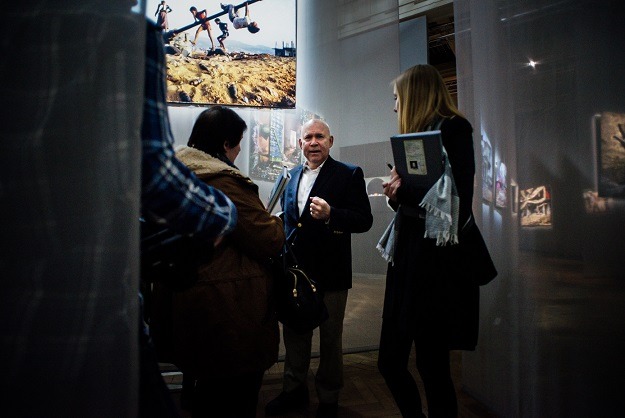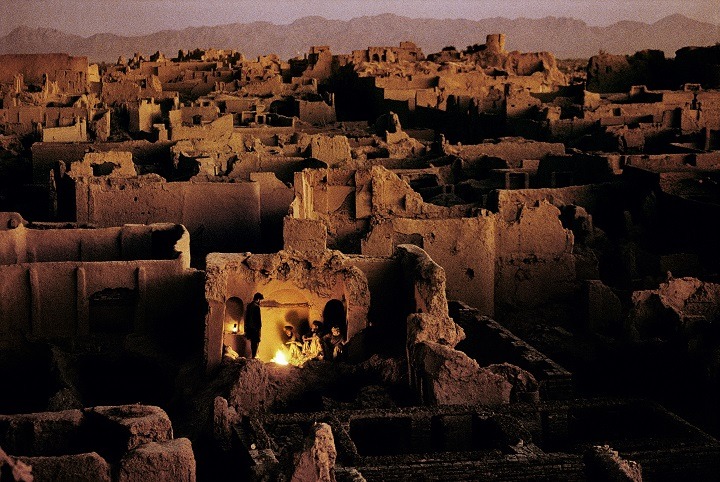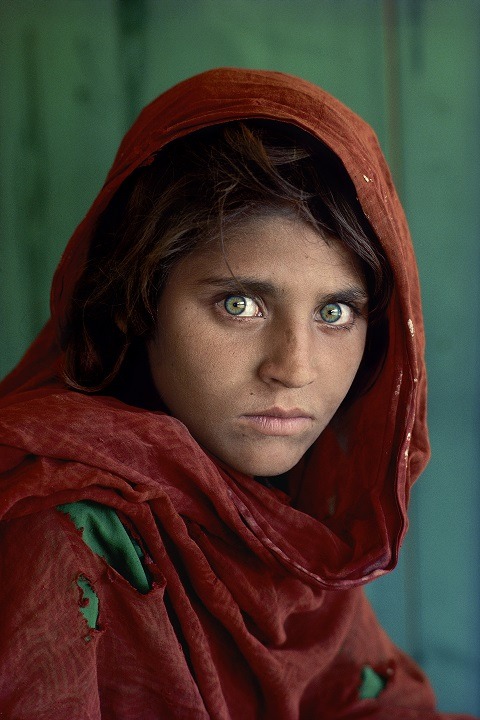Renowned photographer Steve McCurry first visited Brussels in 1969 as one of the first stops on a gap-year of travelling. While at the time of his first visit he had not yet discovered photography, he says nonetheless, “my first awakening was when I started travelling at 19; it set me on a course of travel and having an adventure.” Now he has returned to Brussels with the opening of a retrospective exhibition entitled “The World of Steve McCurry” that is housed in the impressive Palais de la Bourse in the heart of the city. It is his first exhibition in Brussels, as well as the largest-ever retrospective dedicated to McCurry with over 200 photos spanning his 35-year career. In our interview, McCurry spoke warmly of the venue: “It’s an incredible building, the perfect location.”

Award winning photographer Steve McCurry at the opening ceremony of his retrospective exhibition in Brussels. © Christian Ernhede
Born in Philadelphia in 1950, McCurry first started exploring photography while staying with a family in Stockholm during his gap-year travels. He explains that “a young boy in the family was interested in photography, and we used to go out just photographing for its own pleasure; it was new to me to just go out like that without a purpose.” As for the development of McCurry’s characteristic style, he highlights those early years of travelling as a major influence and adds, “I’ve had a particular style, a way of seeing [but] the style is your personality, it’s not something you control.”
After his initial journey to foreign countries, McCurry went back to school in the U.S. to study filmmaking but explains that he found the profession too expensive to pursue. Photography was more accessible. He thus started as a photographer for a local newspaper in Pennsylvania. After three years, his lust for adventure called him to India, where he scraped by as a freelance journalist. And although India is a country that he has returned to several dozen times, it was while covering neighbouring Afghanistan that McCurry’s career as a photojournalist took off in 1979, when he covertly crossed the border with a group of Mujahidin who were fighting the Soviet invasion. His images of the war, published in the New York Times, which identified McCurry as a photographer with inside knowledge and contacts in Afghanistan, were among the first to come out of the country.

Bombed townscape Herat Afghanistan 1992 © Steve McCurry “This bombed out cityscape used to be the city of Herat in Western Afghanistan. This neighborhood had been bombed for 12 consecutive years by the Afghan and Soviet Air force. I visited Herat in the fall of 1992; I was shocked at the devastation. Almost from horizon to horizon as far as you could see was complete devastation. It reminded me of what Dresden in Germany must have looked like during WW2. I realized the impact of this scene and I went back every day for a week photographing at different times of the day, different light... One afternoon I saw this family who had come back and they were starting to rebuild their home and they had a fire going with which they were going to cook their dinner, and I thought this was kind of a rebirth of the city of Herat. And this I thought would be the best example of a sort of “Renaissance”, and was kind of indicative of the spirit of the Afghan people - how against all odds they came back and were going to rebuild their country.”
The retrospective exhibition in Brussels starts where McCurry’s career took off with a number of black and white photographs taken during his first mission to Afghanistan, including several previously unpublished photos. The juxtaposition of the earlier black and white images with later works in characteristically saturated colours also show the sharp progression of McCurry’s career from a photojournalist abiding by the rules that he says come with photographing news, to a more artistic yet documentary approach.

Dust Storm Rajasthan – India, 1983 © Steve McCurry “People often ask me what my favourite picture is. Well, this picture of these women in a dust storm in India might in fact be my favourite picture. I was driving down the road one morning in Rajasthan and all of a sudden this dust storm came out of nowhere. This was pre-monsoon, when it’s hot and dusty, and these dust storms can come up at any moment. As the dust storm kind of enveloped my taxi, my first inclination was to roll the windows up and not to get out but then I thought, wait a minute, the whole purpose of my being here is to photograph this pre-monsoon condition, so I jumped out, I saw these women off the side of the road and I ran off to try and photograph them.”
Following the success of his first major work on Afghanistan, he went on to collaborate with some of the most prestigious magazines, including Time, Life, Newsweek, Geo and National Geographic, and joined the cooperative picture agency Magnum in 1985. In our discussion, McCurry highlighted the importance of many Magnum photographers as personal inspiration and, he says photographers like Eliott Erwitt and Robert Capa “who had a human approach, documenting the world with a humanistic eye, drew me to Magnum,” somewhat cryptically adding “never underestimate the importance of Henri Cartier-Bresson,” the legendary photographer who co-founded Magnum with Capa, among others.
Even in today’s world, where some photographers amass millions of direct followers on social media, McCurry believes in the importance of Magnum: “It’s a group of like-minded people that care about humanity; we’re stronger as a group and can have a stronger voice.” He further explains that at Magnum, “we come with great passion and strong ideas, and it can get very turbulent and lively discussions, that’s a good thing.” McCurry is also happy to list some of the Magnum photographers that he is particularly close to: “Elliott Erwitt, Bruno Barbey, Ian Berry, Hiroji Kubota and of course many others that are no longer with us.”
McCurry has been sent to numerous war zones across the world, none more than Afghanistan, which he has covered for 30 years. It was while covering the Afghan conflict that in 1984 he took a photograph of a young girl, known worldwide as the “Afghan girl” and later identified as Sharbat Gula, who had fled from Afghanistan to the Nasir Bagh refugee camp near the Pakistani border city of Peshawar with her grandmother and siblings after their parents were killed in Soviet bombings. The photograph of Sharbat Gula has become what is probably one of the most iconic images of the twentieth century, as well as emblematic of the National Geographic magazine that published it.

Sharbat Gula, at the Nasir Bagh refugee camp near Peshawar, Pakistan, 1984. © Steve McCurry
The retrospective exhibition pays special tribute to the significance of the photograph of Sharbat Gula, with a section dedicated to the portrait. The exhibition also tells the story of how McCurry, along with a team from National Geographic, tracked down the subject of the iconic photograph 17 years later. A portrait of Sharbat Gula that McCurry took at the time of the reunion makes it clear, from her hardened features, that she has not had an easy life; the hardship of having lived in a country in turmoil for most of her life has left its mark. In an interview with National Geographic at the time, Sharbat Gula said that she has never felt safe “but life under the Taliban was better. At least there was peace and order.” McCurry himself is pessimistic on any potential solution for Afghanistan: “it’s going to go on and on, I think eventually the Taliban will take control.”

Women shoppers dressed in the traditional burqa – Kabul, Afghanistan, 1992 © Steve McCurry “I was walking through the market one morning in Kabul and I saw these women shopping for sport shoes in their traditional ‘burkas’. Photographing women in Afghanistan is a bit of a risk, even though they’re wearing the ‘burka’, you’re still not permitted to photograph them, but the juxtaposition seemed so wonderful that I thought this was a shot worth taking – worth taking a risk for. There’s a taboo against photographing women unless they happen to be your sister, or a member of your family, or your wife or whatever. Street photography is something that I love to practice; I love to walk around the streets of a city and just to see what catches my eye. The power of observation is central to photography, there’s always something interesting to observe in some piece of life...”
While McCurry does not hesitate to show the atrocities of war and violence, he is perhaps most aptly categorised as an explorer of foreign cultures. McCurry however reluctantly agrees to be categorised saying, “that’s part of it” and explains his belief that “travelling and discovering is a great way to spend our time in this world.” In that vein, the exhibition itself progresses as a somewhat chaotic labyrinth of semi-transparent fabric with McCurry’s photos from across the world revealing the richness of different cultures and ethnic groups, without shying away from showing life at its hardest, and connecting with the observer through the tread of a common human heritage. McCurry says that he is “very proud of the exhibition”, and in practical terms adds that “the lighting is really well configured and helps concentrate on the pictures.”

Fishermen at Weligama, Sri Lanka, 1995 © Steve McCurry
At 67, McCurry is surprisingly full of excitement at any possibility of new adventures. When asked if there is any country that he would like to explore further, he excitedly replies “Iran,” a country he has not yet visited. Regarding his latest visit to Brussels, McCurry says that he brought his cameras but due to the opening of the exhibition he did not have time to photograph but adds that “I walked around a bit, interesting architecture, and I would love to come back and do a photo project.”

Dal Lake – Srinagar, Kashmir, 1996
The power of McCurry’s images lies in the focus on the human element. They encourage curiosity and comprehension of the situation of others along with a fostering of cultural understanding. While McCurry’s images speak volumes, his verbal analysis is not long-winded; he says simply that it is not about cultural comparison, “I’m just drawn to those places and somehow ended up spending a lot of time there.” He further explains his belief that “we need to try to get along and celebrate different cultures.”
The promotion of the exhibition with the photograph of the Afghan girl with her shredded clothes, dirt-smudged face and capturing sea-green eyed gaze on lamp post banners on all the major streets in Brussels has a reach far beyond the Palais de la Bourse. It also serves as a stark reminder of the ongoing suffering of refugees from Afghanistan and elsewhere, at a time when understanding and compassion towards refugees in Europe is in high demand.
By Christian Ernhede
| The World of Steve McCurry Exhibition The exhibition runs from 4 March until 25 June 2017 at the Palais de la Bourse in central Brussels. |

